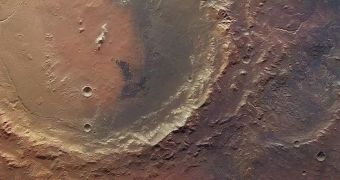Over the past few years, more and more studies have demonstrated that liquid water once existed in abundance on the surface of the Red Planet. The latest studies from the Mars Express spacecraft image a former lakebed in detail, highlighting a fan-shaped river delta as well.
In fact, it was the discovery of the fossilized delta structures that made astronomers suspicious that a lake may have filled the ancient crater billions of years ago. Upon closer inspection of the area, it found that to be the case.
What is interesting about this study is that it clearly demonstrates that large amounts of water existed on the Martian surface in the planet's southern hemisphere. Until now, experts believed that such large expanses of water only existed in the northern hemisphere, where an ocean once laid.
The telltale delta was discovered in the Eberswalde crater, which is about 65 kilometers wide. The image attached to this article shows this landscape feature to the right, half smudged over. To the right, the photo depicts the 140-kilometer-wide Holden crater.
When Holden crater was formed, a long time after Eberswalde, the powerful impact produced a huge ejecta cone that covered half of the neighboring crater when it settled. The first of the two craters formed nearly 3.7 billion years ago, when Mars was very young.
Near the top right of the crater, one can easily distinguish the former river's delta and channels, covering an area of about 115 square kilometers. According to specialists, it was only through the complex action of geological processes that this delta is now revealed.
When water flowed on Mars, sediments carved the landscape feature, but once temperatures dropped, the water disappeared. A fresh set of sediments, this time brought in by the wind, covered the delta.
In time, winds carved at the second “generation” of sediments, exposing the landscape feature underneath as an inverted relief. Mars Express, which has been orbiting the Red Planet since December 25, 2003, is excellently equipped to study such formations.
The NASA Mars Global Surveyor spacecraft was the first to identify and study the delta, before passing the torch to the European Space Agency (ESA) orbiter. Until a few weeks ago, this delta was one of the four finalist targets considered by NASA for the Mars Science Laboratory (MSL) mission.
The MSL rover Curiosity will land in Gale Crater, where a 5-kilometer mountain at the center of the huge depression provides excellent study opportunities of geological eras, Universe Today reports.

 14 DAY TRIAL //
14 DAY TRIAL //